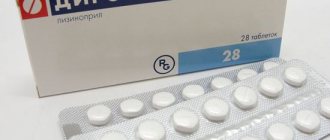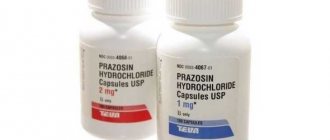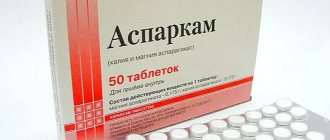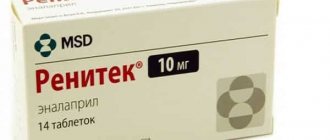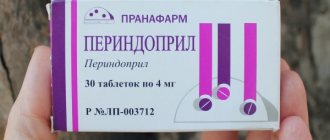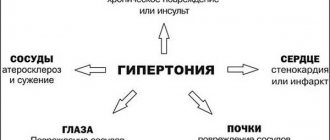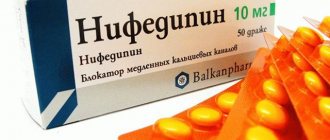The drug "Sotahexal" has a positive effect on high blood pressure, gradually reducing its levels to optimal values. Patients will be able to observe normalization of blood pressure already on the 2nd day from the start of treatment. The dosage and duration of treatment for arterial hypertension with Sotahexal is determined exclusively by a specialized cardiologist individually for each patient.
Mechanism of action of sotalol
The human heart muscle contains so-called beta1-adrenergic receptors - when these receptors are exposed to adrenaline, the heart rate increases and the force of heart contractions increases.
Sotahexal, as indicated in the instructions for use, binds receptors and protects them from the effects of adrenaline, thereby realizing its therapeutic effect.
The mechanism of action of Sotahexal is due to the following mechanisms:
- Slowing down the rate of repolarization - the process of restoring the charge of cell membranes after an excitation wave passes through them.
- Lengthening the period of absolute refractoriness - the time during which the heart muscle does not respond to electrical impulses.
- Prolongation of the action potential.
Unlike antiarrhythmic drugs from class III (amiodarone), Sotahexal does not have its own membrane-stabilizing effect.
As a result of these effects, a decrease in heart rate and a moderate decrease in the intensity of heart contractions occurs. The final result of the action is a decrease in the need of myocardial cells for oxygen and a decrease in the overall cardiac load.
What does it help with?
Supraventricular arrhythmias are an absolute indication for the use of sotalol, part of Sotahexal. What does this drug help with according to the instructions:
- fibrillation (chaotic contraction of the atria);
- heart flutter (atrial contraction with a frequency of over 200 beats per minute);
- Wolff-Parkinson-White syndrome, in which rhythm disturbances are periodic;
- ventricular tachycardia - a condition in which the pacemaker is the ventricles of the heart, and not the sinoatrial node;
- ventricular extrasystoles are extraordinary contractions of the heart that disrupt the normal functioning of the heart.
Normal and atrial fibrillation
Contraindications
The use of Sotahexal, according to the instructions, is contraindicated in cases where it can provoke an excessive decrease in heart rate or cause a pronounced drop in blood pressure. Before prescribing, you should carefully read the “Contraindications” section of the instructions for use of Sotahexal tablets. What is sotalol contraindicated for:
- necrosis of the heart muscle (heart attack);
- chronic form of heart failure in an advanced stage;
- SA blockade (impossibility of conducting an excitation impulse from the sinus to the atria);
- cardiogenic shock;
- heart block 2 or 3 degrees;
- bradycardia - a condition in which the heart beats no more than 50 beats per minute;
- severe arterial hypotension - blood pressure below 90 mm Hg. Art.
- acidosis - “acidification” of the blood in various diseases;
- obliterating atherosclerosis.
Important! According to the instructions, Sotahexal is not prescribed for use if a person has an individual intolerance to its components or an individual intolerance to sulfonamides (a cross-reaction is possible).
A contraindication, according to the instructions, is the presence of long-term pulmonary obstruction (COPD) or any form of bronchial asthma in the patient. This is explained by the fact that there are beta2-blockers in the lungs and the effect of Sotahexal on them leads to a worsening of the course of these diseases. Shortness of breath increases, the degree of blood oxygen saturation decreases.
Sotahexal should be prescribed with caution to patients with diabetes - it induces hypoglycemic conditions. Such patients should more carefully select the dosage of insulin, as indicated in the instructions for use, so it is better to consider replacing Sotahexal with other medications.
Analogs
Sotalol Canon
Obzidan
Propranolol
Sotalex
Anaprilin
All types of similar medicines and dietary supplements are represented by medicines with a similar content of active components, spectrum of use, purpose or pharmacological action: Darob, Sotalex, Sotalon Canon, Sotalol hydrochloride, Anaprilin, Vero-Anaprilin, Obzidan, Inderal, Korgard, Diacordin Retard, Arythmil Diacordin, Gallopamil, Amiodarone, Bretylia tosylate and others.
Instructions for use
The use of Sotahexal on its own is possible only after it has been prescribed by a doctor, according to the instructions.
You should not adjust the dosage regimen yourself, as adverse events and a decrease in the therapeutic effect are possible.
How to take the medicine?
The instructions for use indicate that sotalol tablets are swallowed whole, washed down with a small amount of water at room temperature. They should be taken 1–1.5 hours before meals.
Dosage
The dosage of Sotahexal is selected according to the instructions, taking into account the individual characteristics of each patient. Application usually starts with 80 mg per day (40 in the morning and evening). If the effect is insufficient, the dose should be gradually increased by 40 mg daily to a final dose of 240–320 mg. The average dose, as indicated in the instructions for use, is 240 mg. In extremely advanced cases, with resistant tachycardia, it is permissible to use a maximum daily dosage of 480 mg, divided into three times. However, this should only be done if the possible positive effect of the application outweighs the possible risk.
Is it possible to overdose?
Exceeding the course dose of Sotahexal or a single dose of an overdose can cause poisoning, as stated in the instructions for use. Symptoms of Sotahexal overdose:
- drop in blood pressure;
- hypoglycemia (decreased amount of glucose in the blood);
- bradycardia - decreased heart rate;
- generalized seizures;
- torsade de pointes;
- loss of consciousness;
- in special cases, asystole (cardiac arrest) may develop and be fatal.
Treatment of overdose, according to the instructions for use, should be started as early as possible. What to do in case of an overdose of Sotahexal: if the tablets were taken recently, gastric lavage will be effective - after 2 hours, lavage will have virtually no effect. For bradycardia, atropine is prescribed; for low blood pressure, adrenaline is prescribed. For severe bronchospasm, inhaled beta-agonists are prescribed. In a hospital setting, the most effective way is to use a temporary pacemaker, which will set the rhythm of the heart until the drug is removed from the body.
Important Notes
Treatment with Sotahexal must be accompanied by monitoring of blood pressure and heart rate - it is recommended to measure these parameters at least 2 times a day.
ECG monitoring should be carried out weekly throughout the dose selection period. In case of sudden hypotension (fall in blood pressure) or clinically noticeable bradycardia, the dose should be adjusted based on the instructions for use.
For patients with pheochromocytoma (a tumor of the adrenal gland that synthesizes large amounts of adrenaline), Sotahexal is prescribed in parallel with alpha-blockers.
Discontinuation of this medication should only be done by gradually reducing the dosage, since sudden withdrawal often leads to life-threatening arrhythmias.
If Sotahexal was prescribed to a pregnant woman, it should be stopped 2-3 days before the expected birth, which will minimize the risk of bradycardia, hypotension and hypoxia in the baby.
The instructions for use reflect all the nuances of prescribing Sotahexal. How to take the drug: It is contraindicated to take the tablets with food or drink them with milk and dairy products, as this significantly reduces its effectiveness.
Overdose
Symptoms: decreased blood pressure, bradycardia, bronchospasm, hypoglycemia, loss of consciousness, generalized seizures, ventricular tachycardia; in severe cases - symptoms of cardiogenic shock, asystole.
Treatment: gastric lavage, hemodialysis, administration of activated carbon. Symptomatic therapy: atropine - 1-2 times intravenously; glucagon - first in the form of a short IV infusion at a dose of 0.2 mg/kg body weight, then at a dose of 0.5 mg/kg body weight IV infusion over 12 hours.
Side effects
The side effect of Sotahexal is due to its beta-adrenergic blocking effect. Since these receptors are found in all organs and tissues, the side effects are very diverse. Some patients experience the following side effects from Sotahexal (listed in the instructions for use):
- from the heart and blood vessels: excessive decrease in heart rate, drop in blood pressure, fainting, angina attacks;
- from the nervous system: fatigue, depression, sudden mood swings, sleep disorders;
- from the stomach and intestines: dry mouth, increased gas formation in the intestines, diarrhea or constipation;
- from the lungs: bronchospasm, manifested by a feeling of lack of air, shortness of breath;
- from the eyes: dry eye syndrome, conjunctivitis, decreased visual acuity;
- decreased potency and libido;
- muscle weakness;
- skin manifestations: itching, urticaria, psoriasis-like dermatosis;
- hypoglycemia (occurs in patients with diabetes).
Review of reviews from cardiologists
The active substance of Sotahexal, as noted in the instructions - sotalol, was invented in 1989, after clinical trials it was patented in 1993. According to cardiologists, sotalol was at one time a very effective drug compared to antiarrhythmics of other groups. Since that time, more effective drugs have appeared, in particular selective beta blockers, as well as cordarone.
According to reviews from cardiologists, Sotahexal has a large number of side effects, moreover, it does not have a very convenient dosage regimen - the daily dose must be divided into 2-3 doses. There are medications that are taken once a day, usually in the morning.
However, Sotahexal also has advantages over other drugs - it is relatively low price and easy to select a dose. The advantages of this medicine include the fact that equilibrium concentration in the blood is achieved within 2–3 days of administration. If you accidentally miss another pill, this allows you to maintain the therapeutic effect without increasing the risk of arrhythmia.
Composition and release form
The drug is presented in pharmacy chains in the form of round white tablets, which are packaged in blisters of 10 pieces - 1, 2, 3, 5, 10 units in a cardboard pack. Tablets have two varieties: 160 and 80 mg. Composition of one piece:
Articles on the topic Anaprilin analogues Abstract Kagocel How to take betaloc zok
| Compound | Weight, mg |
| Sotalol hydrochloride (active ingredient) | 80/160 |
| Additional components: lactose monohydrate, corn starch, colloidal silicon dioxide, magnesium stearate, hyprolose, sodium carboxymethyl starch. | |
What can be replaced?
If there are contraindications to the use of Sotahexal and the above-mentioned drugs, it is possible to replace them with more modern drugs with selective effects - beta1-blockers. How to replace Sotahexal, according to the instructions:
- Atenalol (Prinorm, Tenorik);
- Nebivalol (Nebilet);
- Esmolol (Breviblok).
If it is impossible to use these drugs for the treatment of arrhythmias, drugs from related groups of antiarrhythmics are used: calcium channel blockers, potassium channel activators and others. The specific drug is determined by the doctor after a thorough examination, including ECG recording, Holter monitoring (24-hour ECG recording), and 24-hour blood pressure monitoring (ABPM). The dosage for use is calculated according to the instructions.
Which is better - Cordarone or Sotahexal?
In some cases, doctors may prescribe Cordarone or Sotahexal - which one is better to choose? The formulation of this question is somewhat incorrect - you cannot choose just one drug from these medications - Sotahexal or Cordarone. There are situations when, according to the instructions, it is necessary to take both of these drugs at once so that they complement each other’s action. Indications for the combined use of Sotahexal and Cordarone:
- prevention of atrial fibrillation;
- treatment of refractory ventricular extrasystole.
Some studies have noted that when cordarone is ineffective, adding a beta blocker even at half the dosage can achieve a therapeutic effect.
It is worth noting that Cordarone, according to the instructions, belongs to a later generation of antiarrhythmic drugs; it realizes its effect through several mechanisms:
- stabilization of cell membranes responsible for excitation;
- partial blockade of calcium channels;
- inhibition of potassium channels.
Due to the wider range of actions described in the instructions, the use of cordarone is considered more effective compared to Sotahexal. However, it also has disadvantages, for example, its use, according to the instructions, is contraindicated in patients with concomitant pathology of the thyroid gland, since it contains iodine.
Interaction
When starting to take Sotahexal, it is important to study its compatibility with other medications. So, if you simultaneously use the antihypertensive drug Sotahexal with the drug Verapamil, a sharp decrease in blood pressure is possible. The risk of developing hypotension increases when using Sotahexal in combination with antidepressants, phenothiazines and narcotic drugs. Blood pressure may drop significantly if Sotahexal and a diuretic are taken together. Symptoms of hypoglycemia are observed when the drug is used together with hypoglycemic drugs; this combination is especially dangerous during physical activity. When using Sotahexal with xanthines, the antiarrhythmic and hypotensive effects may be reduced.
